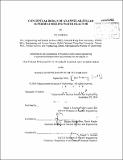| dc.contributor.advisor | Mujid S. Kazimi. | en_US |
| dc.contributor.author | Ko, Yu-Chih, Ph. D. Massachusetts Institute of Technology | en_US |
| dc.contributor.other | Massachusetts Institute of Technology. Dept. of Nuclear Science and Engineering. | en_US |
| dc.date.accessioned | 2013-02-14T15:34:14Z | |
| dc.date.available | 2013-02-14T15:34:14Z | |
| dc.date.copyright | 2010 | en_US |
| dc.date.issued | 2011 | en_US |
| dc.identifier.uri | http://hdl.handle.net/1721.1/76976 | |
| dc.description | Thesis (Ph. D.)--Massachusetts Institute of Technology, Dept. of Nuclear Science and Engineering, February 2011. | en_US |
| dc.description | "September 2010." Cataloged from PDF version of thesis. | en_US |
| dc.description | Includes bibliographical references (p. 219-225). | en_US |
| dc.description.abstract | The conceptual design of an annular-fueled superheat boiling water reactor (ASBWR) is outlined. The proposed design, ASBWR, combines the boiler and superheater regions into one fuel assembly. This ensures good neutron moderation throughout the reactor core. A single fuel design is used in the core. Each annular fuel element, or fuel tube, is cooled externally by boiling water and internally by steam. Fuel pellets are made of low enrichment U0 2, somewhat higher than the traditional BWR fuel enrichment. T91 and Inconel 718 are selected as candidates for the cladding material in view of their excellent physical properties and corrosion resistance. The fuel-cladding gap is filled with pressurized helium gas, like the existing lighter water reactor fuels. The ASBWR fuel assembly contains sixty annular fuel elements and one square water rod (occupying a space of four fuel elements) in an 8 by 8 square array. Annular separators and steam dryers are utilized and located above the core in the reactor vessel. Reactor internal pumps are used to adjust the core flow rate. Cruciform control rods are used to control the reactivity of the core, but more of them may be needed than a traditional BWR in view of the harder spectrum. The major design constraints have been identified and evaluated in this work. The ASBWR is found promising to achieve a power density of 50 kW/L and meet all the main safety requirements. This includes a limit on the minimum critical heat flux ratio, maximum fuel and cladding operating temperatures, and appropriate stability margin against density wave oscillations. At the expected superheated steam of 520 °C, the plant efficiency is above 40%, which is substantially greater than the efficiency of 33 to 35% that today's generation of LWRs can achieve. In addition to generating electricity, the ASBWR may also be useful for liquid fuel production or other applications that require high temperature superheated steam. The uncertainties about this design include the performance of cladding materials under irradiation, the attainment of desirable heat transfer ratio between the external and internal coolant channels throughout the fuel cycle, and the response to the traditional transients prescribed as design basis events. | en_US |
| dc.description.statementofresponsibility | by Yu-Chih Ko. | en_US |
| dc.format.extent | 362 p. | en_US |
| dc.language.iso | eng | en_US |
| dc.publisher | Massachusetts Institute of Technology | en_US |
| dc.rights | M.I.T. theses are protected by
copyright. They may be viewed from this source for any purpose, but
reproduction or distribution in any format is prohibited without written
permission. See provided URL for inquiries about permission. | en_US |
| dc.rights.uri | http://dspace.mit.edu/handle/1721.1/7582 | en_US |
| dc.subject | Nuclear Science and Engineering. | en_US |
| dc.title | Conceptual design of an annular-fueled superheat boiling water reactor | en_US |
| dc.type | Thesis | en_US |
| dc.description.degree | Ph.D. | en_US |
| dc.contributor.department | Massachusetts Institute of Technology. Department of Nuclear Science and Engineering | |
| dc.identifier.oclc | 824797566 | en_US |
